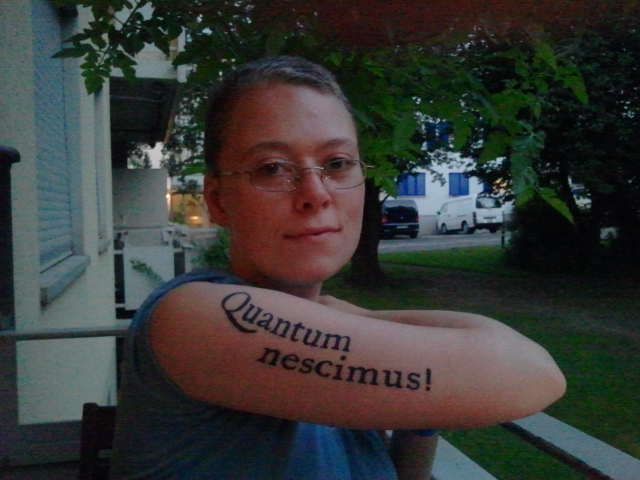
Me sitting on the balcony of my flat, showing off my tattoo.
It says Quantum nescimus! and don't worry, I don't speak Latin either. (I did make very sure this was the correct spelling before getting it tattooed, though.)
So far only two people have translated it correctly at first glance, one of them an amazing seventy-eight-year-old woman we met at a dinner party for Girton graduates. At both this dinner party and the Open Knowledge Conference, where I volunteered, my tattoo was big hit, so perhaps it's time to explain it officially.
Quantum nescimus is a Latin phrase that can be translated as, "How much we don't know." I discovered it in this lecture, given in 1992 by Sir John Cornforth on the position of scientists in society. Goodness only knows how I came to be reading the lecture, but it stuck firmly with me.
It may seem odd that a system of knowledge based on doubt could have been the driving force in constructing modern civilisation. At its foundation in 1660 the Royal Society of London, for improving natural knowledge, was given by a quaint and still surviving custom a coat of arms and a motto. One motto considered was "Quantum nescimus", which translates as "What a lot we don`t know". It is a good motto and I don't know why it was not adopted. Perhaps some much mistaken person thought that it wouldn't be true for long enough. In the end, the one chosen was "Nullius in verba". This means, from its original context, "We take nobody’s word for it".
Anyone, of course, can disbelieve anything, but a scientist`s unbelief also carries an obligation. You may make interpretations of what has been found out, but you must not believe them to be wholly true or complete; you or your successors must look again, and look beyond. Again, many people find perpetual unbelief a most uncomfortable idea, especially as a basis for action. But once you have accepted, as a scientist, that there are probabilities but no certainties, there is nothing unnatural in acting on your judgement of the odds for and against. That is what we all do most of the time, even if we do not always know it. And when I say "we" in this lecture, I don’t mean scientists, I mean the whole human species.
For me, the phrase, "Quantum nescimus," is both beautiful and powerful. As a scientist, I have the obligation to keep in mind how much there is I don't know, both to perform good science and to perform responsible science. As a person, remembering this should also help me to behave sensitively to my fellow human beings, and to seek out as much knowledge of the world as I can get. This is by no means a burden; instead it's thrilling. My explanation to people who ask usually comes down to this:
There is so much that we don't know that we can keep doing science for as long as we like, and not worry about running out of things to discover. Isn't that wonderful?
The exclamation mark is there because I find this so exciting. The font is IM Fell English, a seventeenth-century type with an interesting history, which is available free and open source on Google Fonts. I love the long tail of the Q and the way it moves with the muscle of my arm. (As Alex pointed out, my tattoo also marks me out as a typography geek.)
More tattoos? By the time I'm 40, I hope to be covered in them. My next one is all drawn up and waiting for the opportunity to be laid under my skin. Watch this space.